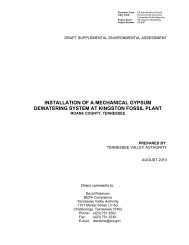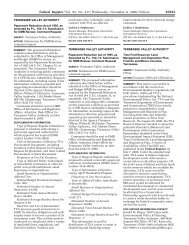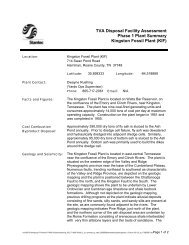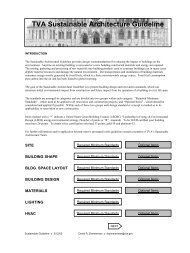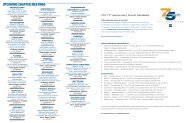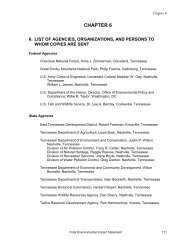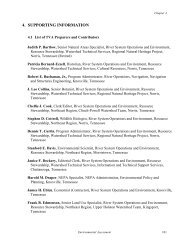Corrective Action Plan - Tennessee Valley Authority
Corrective Action Plan - Tennessee Valley Authority
Corrective Action Plan - Tennessee Valley Authority
You also want an ePaper? Increase the reach of your titles
YUMPU automatically turns print PDFs into web optimized ePapers that Google loves.
Kingston Ash Release March 2009<br />
<strong>Corrective</strong> <strong>Action</strong> <strong>Plan</strong><br />
All data will be collected following TVA sampling Standard Operating Procedures and the sitewide<br />
Quality Assurance Project <strong>Plan</strong> currently under development. An independent assessment<br />
of sampling techniques will occur periodically to ensure the quality of the data being collected.<br />
Only data and information meeting the sampling and laboratory quality requirements will be<br />
used.<br />
Data Evaluation. Once the data are available, they are evaluated for quality and then for<br />
scientific information. EPA Region 4 procedures for data quality will be followed. For instance,<br />
data being used for risk assessment work will be validated. Standard operating procedures are<br />
under development for data management activities so all data are evaluated and stored<br />
appropriately.<br />
Other data evaluation activities will include assessing the nature and extent of contamination in<br />
the various media as well as transport between media. If appropriate to the decision, sediment<br />
transport modeling may be conducted to assess future potential migration of unremediated ash.<br />
Data will be compared to various regulatory and risk-based levels during the evaluation to focus<br />
any further evaluations. Criteria that will be considered for evaluation include drinking water<br />
standards, Water Quality Criteria for the protection of aquatic life, industrial and residential<br />
preliminary remediation goals (PRGs), ecological benchmarks, and any other chemical-specific<br />
ARARs.<br />
Risk Assessment. A baseline risk assessment is performed to identify the existing or potential<br />
risks that may be posed to human health and the environment by the site. This assessment<br />
also serves to support the evaluation of the no-action alternative by documenting the threats<br />
posed by the site based on expected exposure scenarios. Because this assessment identifies<br />
the primary health and environmental threats at the site, it also provides valuable information for<br />
the development and evaluation of alternatives.<br />
For soil/ash exposure pathways, depending on the amounts of ash left after the short-term<br />
management actions, it is anticipated that both a residential and industrial future hypothetical<br />
user will be evaluated in the human health risk assessment. Likewise, future industrial and<br />
residential use of the groundwater will likely be evaluated. Recreational use of adjacent surface<br />
water would be evaluated as well as residential use to assess baseline conditions.<br />
The receptors evaluated for the ecological risk assessment are less clear at this stage although<br />
risk to benthic invertebrates, fish, aquatic amphibians and reptiles, piscivorous wildlife, aerial<br />
insectivores, and various other terrestrial species are likely to require evaluation. A continuation<br />
of the discussions initiated with the ecological stakeholders in January 2009 is needed to<br />
assess the scope of the ecological risk assessment.<br />
If agreement is reached to make a decision on just parts of the residual contamination, some of<br />
the receptors discussed above may not be relevant to that decision and therefore not evaluated.<br />
Evaluation of Alternatives. The no-action alternative will be considered for any decision made.<br />
It will set baseline conditions that will exist if nothing further is done. Depending on the size and<br />
complexity of the decision, one to several more alternatives will be engineered and evaluated.<br />
The proposed Interagency Team would help scope out the range of alternatives to be<br />
considered, ensuring that all preferred alternatives are given equal consideration. A key<br />
decision that is needed will be the final end-state of the area affected by the ash. To make a<br />
sound decision, a range of final end-states are likely to be evaluated so the benefits and<br />
impacts of each can be assessed. If the decision is simpler, a streamlined evaluation may be<br />
2-19





